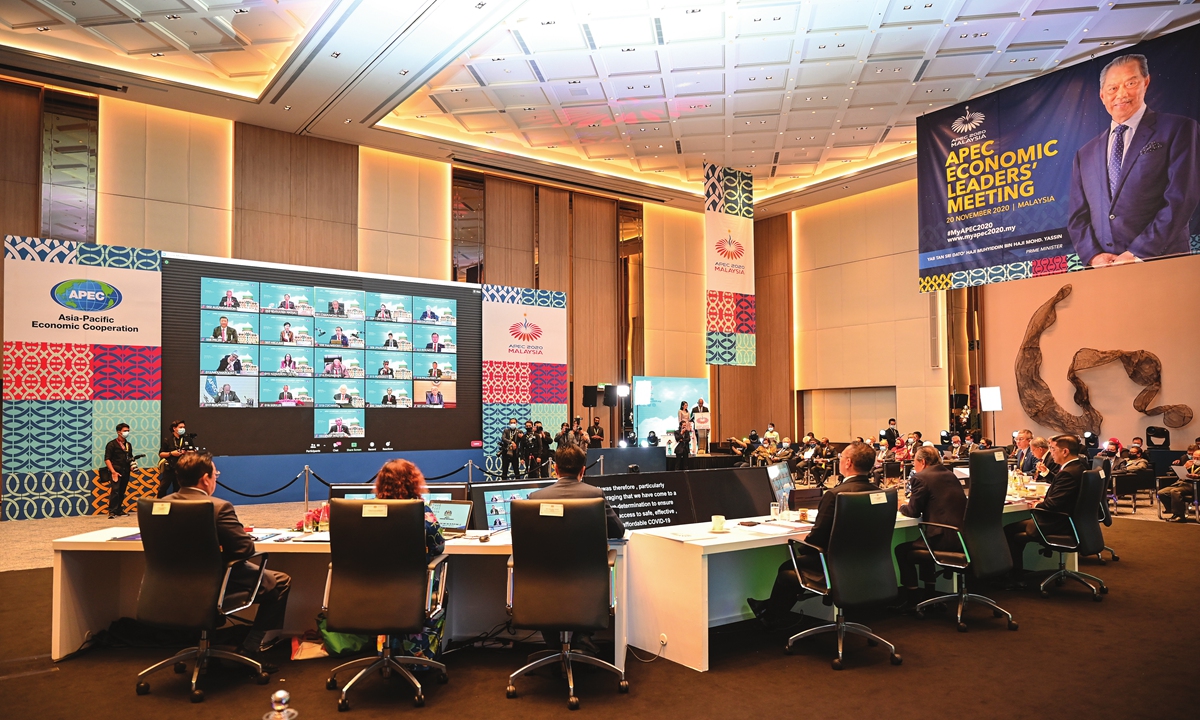
World leaders are shown on a large screen holding up their copies of the 2020 Kuala Lumpur Declaration during the online Asia-Pacific Economic Cooperation (APEC) leaders’ summit in Kuala Lumpur on Friday. Photo: AFP
At the end of a tough year in which the world has badly suffered from the deadly COVID-19 pandemic, members of the Asia-Pacific Economic Cooperation (APEC) sat together and jointly revealed a new vision for the next two decades. It offers a crucial growth engine for the global economy in the post-pandemic era and a rosy prospect for international community, which is in need of comprehensive cooperation, experts said on Saturday.
After 26 years since the announcement of the 1994 Bogor Goals, the APEC Putrajaya Vision 2040 came at a critical time, envisioning "an open, dynamic, resilient and peaceful Asia-Pacific community by 2040, for the prosperity of all our people and future generations," read the statement.
The vision highlighted three major economic drivers for its future efforts, including trade and investment, innovation and digitalization, as well as strong, balanced, secure, sustainable and inclusive growth.
It sends a signal that, by 2040, the global economic center, innovation center and market center are set to shift to the Asia-Pacific region, Wei Jianguo, former Chinese vice minister of commerce and executive deputy director of the China Center for International Economic Exchanges, told the Global Times on Saturday.
"Covering over 60 percent of the global economy, the APEC's new vision lays a solid foundation for the growth of the economies and the prosperity of billions of residents."
The joint communique underlines its support for agreed upon rules of the WTO in delivering a well-functioning multilateral trading system and promoting the stability and predictability of international trade flows. While the global economy has been undermined by rising protectionism promoted by some Western countries led by the US, the APEC vision reaffirmed its stance on safeguarding multilateralism and free trade, with an aim to promote regional economic integration based on market rules, instead of one country's interest or desire, Wei noted.
The Vision also highlights the economic driver of innovation and digitalization, which has made good progress in the Asia-Pacific region. "China has seen accelerated development of digital economy, 5G and internet plus approaches, which has created momentum for the Chinese economy and even economies in the Asia-Pacific region," Wei said.
By underlining the efforts in promoting the development of new forms and models of the digital economy, the APEC new vision captures the booming trend of the digital economy and will generate a new driving force for the regional economy, Xinhua News Agency reported, citing Yang Zhengwei, an official from China's Ministry of Commerce.
"With innovation and digitalization as an engine, there would be a second wave of globalization in three to five years after the pandemic, despite the persistence of certain degree of anti-globalization push," Wei said.
Though the US led by Trump administration has been relentlessly confronting China from triggering a trade war to cracking down on Chinese tech firms, Wei noted that the future scope of cooperation between the two largest economies remains wide in the long run, including innovation and digitalization, as digitalization is comprehensively expanding to areas such as epidemic containment and environment protection.
Since the implementation of the Bogor Goals 26 years ago, remarkable progress has been made in trade and investment liberalization and facilitation in Asia-Pacific, Yang said, elaborating that trade and investment in the region have been growing at a high speed, with trade volume increasing five times with an average annual growth rate of 6.7 percent, and two-way investment increasing 12 times with an average annual growth rate of over 10 percent.
Multilateralism, free trade and regional economic integration have been major forces driving the rapid growth of the region. Making a long-term commitment to supporting multilateralism, it has demonstrated a firm determination of the members to promote regional integration, Yang said.
Global Times
